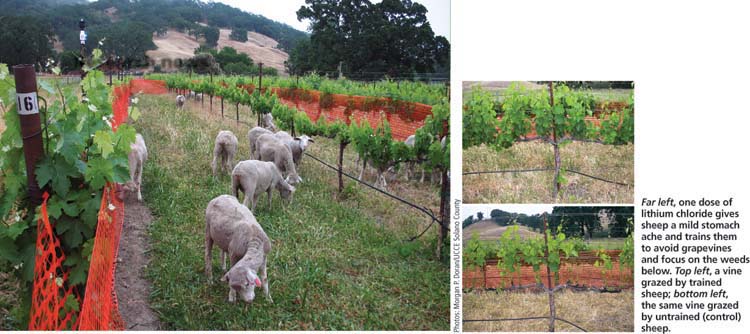All Issues
Trained ovines chomp on weeds, avoid vines
Publication Information
California Agriculture 62(1):10-10.
Published January 01, 2008
PDF | Citation | Permissions
Full text
To most vineyard managers, any plants growing directly under grapevines are nasty weeds that can rob the crop of water and nutrients. But to sheep, these weeds are tasty and nutritious forage. This would make sheep (ovines) ideal for controlling vineyard weeds except for one thing — these herbivores like grape leaves just as much.
Far left, one dose of lithium chloride gives sheep a mild stomach ache and trains them to avoid grapevines and focus on the weeds below. Top left, a vine grazed by trained sheep; bottom left, the same vine grazed by untrained (control) sheep.
Some managers get around this problem by using miniature “babydoll” sheep that are too short to reach grape leaves. However, while effective, these sheep are also expensive. Other managers use sheep only when the grapevines are dormant, but this means switching to other weed control methods that have their own drawbacks during the growing season. For example, mowing entails increased fuel costs and soil compaction, and herbicides can contaminate surface waters ( see page 19 ).
To find a better alternative, UCCE researchers are training sheep not to eat grape shoots and leaves. “We got the idea from a workshop on manipulating what animals eat,” says project leader Morgan Doran, a Solano County livestock advisor. The workshop was by Fred Provenza of the Utah State University program BEHAVE, which stands for Behavioral Education for Human, Animal, Vegetation and Ecosystem Management ( http://www.behave.net ). This program focuses on how animals decide what to eat, and includes finding ways to encourage herbivores to eat invasive weeds and discourage them from eating desirable plants.
To train sheep, Provenza recommended letting them eat as many grape leaves as they wanted and then giving them a small dose of lithium chloride, which is harmless but causes a mild stomach ache. He also recommended training young sheep rather than adults. “You need to mold them at an early age, before they've had much dietary experience,” Doran says.
First, the UCCE team did a pilot project on ewe lambs at UC Davis. These lambs had been raised on alfalfa pellets, and a single dose of lithium chloride was enough to make the lambs steer clear of grape leaves. Next, the team moved on to a field study of 40 range-raised lambs at the UC Hopland Research and Extension Center. These lambs were used to eating a variety of plants, and getting them to avoid grape leaves required an additional, slightly higher dose of lithium chloride (still well below toxic levels).
The sheep aversion training has been remarkably effective. Nine months after their lithium chloride doses, the 40 Hopland sheep still ignored vigorous growth on grapevines right in front of their faces, preferring to munch on the weeds growing beneath the vines. “They were comparable to normal floor management,” Doran says.
However, the possibility remains that even trained sheep will eventually balk at eating some vineyard floor plants and try grape leaves again. “It depends on the grazing management,” Doran says.” If they don't have enough feed or enough palatable feed, they will transition from floor vegetation to grape leaves.”
So far the researchers haven't found any weeds that the trained sheep don't like. But there are cover crops that sheep don't enjoy. “Some clovers, such as balansa, are bitter in the spring, which made the sheep start nibbling on grape leaves,” Doran says. He recommends subterranean clover and ryegrass as good cover crops for trained sheep.
Besides benefiting vineyard managers, using sheep to control weeds could also help sheep producers. Weed-eating sheep would reduce forage costs and give producers the new market of renting out their flocks' services. “The lamb market oscillates up and down quite a bit, and this could give sheep producers a more secure source of income,” Doran says.





